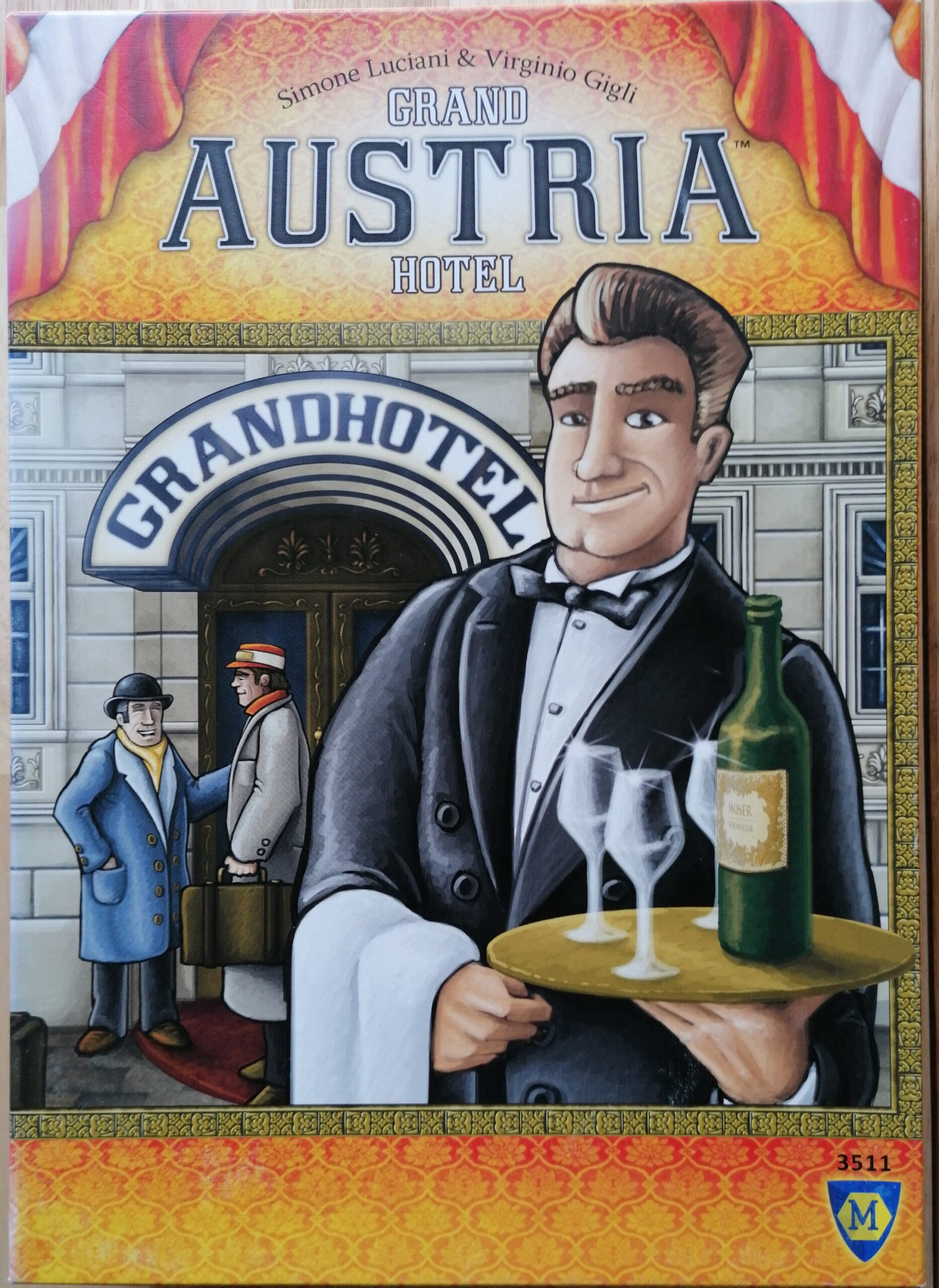Grand Austria Hotel was a game that started a trend in my board game buying habits, in that I meticulously researched it. Prior to this, I’d have watched one, maybe two reviews of a game, and instantly got a feeling as to whether I would like or dislike a game, leading to the decision about whether I should buy it or not. With this one, I’d heard it spoken about, I’d watched reviews, even part of a playthrough, but I still couldn’t make up my mind. It was only after a few weeks or so, when my mind kept drifting back to it, did I pull the trigger, and for the most part, with every purchase of a game since, I have followed this method. Nine times out of ten, I’ve come away happy, and Grand Austria Hotel is no exception.
In this game, you take on the role of a hotel manager, trying to amass the most points. One way you will do this is by filling rooms in your hotel. The only way to fill your rooms is by feeding your guests in your restaurant. At the start of the game, five guests are placed on the main board, and each player will get to choose one to start the game with. Then, on every subsequent turn, you will get to take another, paying to attract them to your restaurant if necessary. Though this doesn’t really do anything for the theme, having to pay for the most recently revealed cards is something that’s done in a lot of games, and works well in deterring a player from taking a card that’s just come out that you may really want.
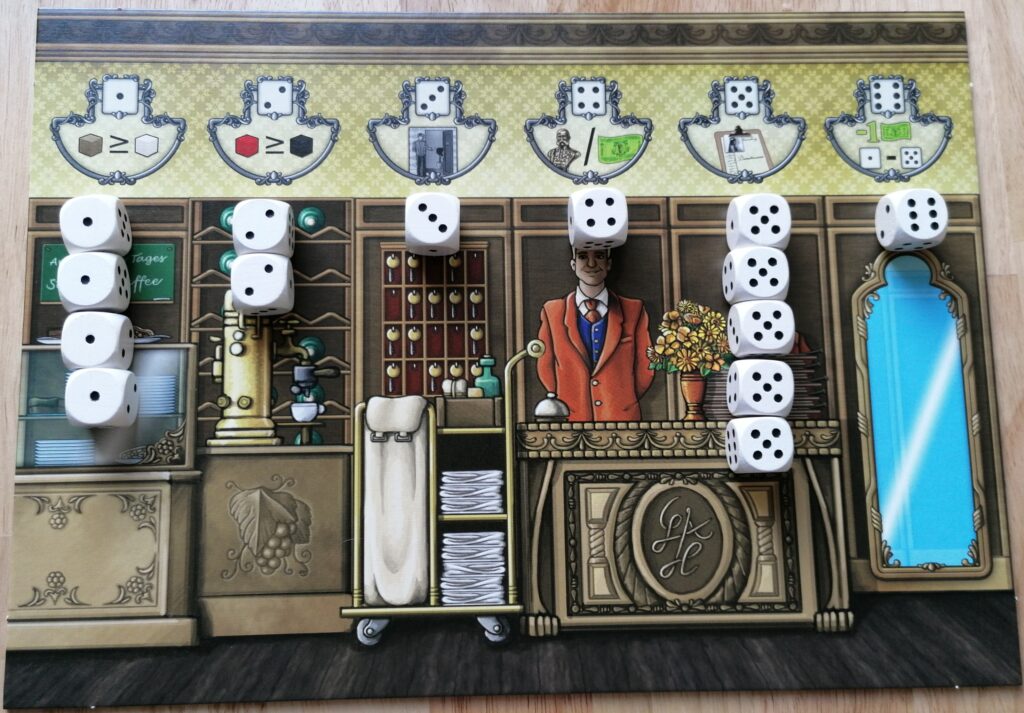
In Grand Austria Hotel, each player gets two actions per round. To begin the round someone will roll a certain amount of dice (based on player count), and arrange them on the action board based on the number they show. This determines which actions will be available during the round, as well as how powerful the actions will be. In turn order, players will draft dice to perform actions in what’s called a snake draft. This means that the first player, as an example, will choose their first die first, but will then be the last to take their second die. This way of drafting is one that I very much enjoy, as there is no real advantage to going first.
When a player takes a die, they will be looking at the amount of dice in a column as much as the number of the die. In the example pictured, there are four dice showing a one, so this means that if a player takes a one die, they will perform that action four times.
The actions associated to numbers one and two are perhaps the most interesting in this game, as they come with an added puzzle. As shown by the greaten-than or equal sign, you can only gain one of the resources (cake/coffee) if you have gained one or more of the other type of resource (strudel/wine). Whenever you gain these resources, you can place as many as you can onto guests in your restaurant, but you could also put them in your kitchen for use later. As with a lot of games, I enjoy having puzzles to figure out within the main puzzle, and this one works well.
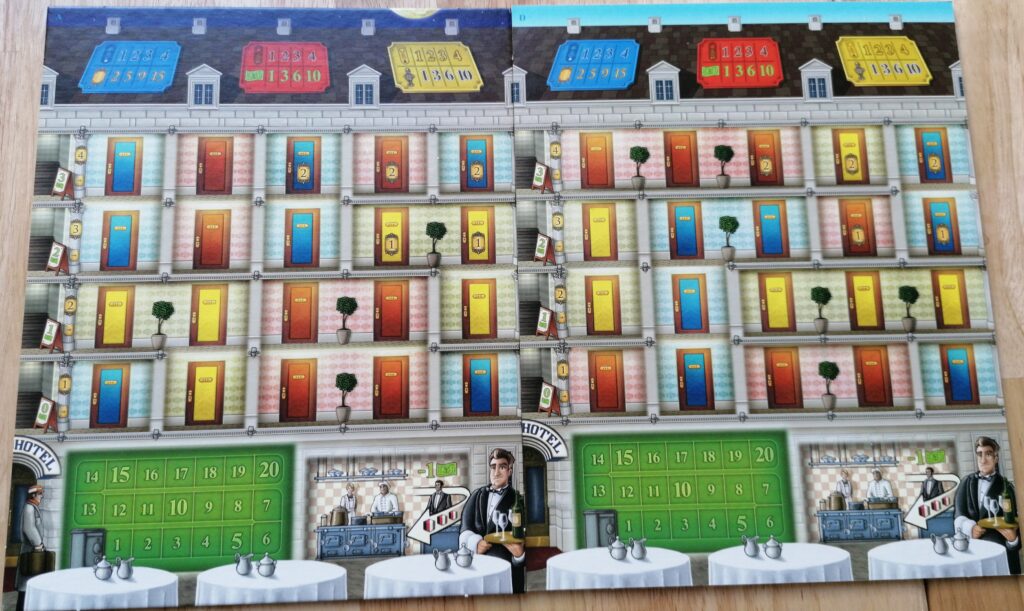
Another interesting part of Grand Austria Hotel is the rooms. Before you begin the game, each player gets to ready three rooms in their hotel, starting from the bottom left of the board and moving adjacently. To ready a room you just take a coloured room tile, open door side up, place it on the same-coloured door on your player board, and then pay between zero and three krone(s) (money) depending on which floor of the hotel the room is on. You can’t remove a guest from your restaurant, even if you’ve given them all the food/drink they require, until a room that matches their colour is open (green guests are wild). Depending on the difficulty of the guests you take, and whether they match up with the current open rooms, you could fulfil the first three quite quickly, but sooner or later you’ll need to take an action to open more.
Player boards are double-sided, with one side being asymmetric, in that the arrangement of the rooms is different. Though it doesn’t necessarily mean that you’re more skilled if you use the asymmetric side, the groupings of certain coloured rooms is important. This is because if you complete a group of rooms (by placing guests in all of them) of the same colour, you gain a bonus, which is shown at the top of your player board. A group is considered to be any room that is adjacent of the same colour. As an example, if you complete a group of one, two, three or four blue rooms, you gain two, five, nine or fifteen points respectively. On the symmetric side of the board (pictured on the left), there are no groups of more than two blue rooms, but on the asymmetric side pictured, there is a group of four, a group of one and a group of two. Though quite a small part of the game, it is a nice addition, as I always enjoy games which give you bonuses, and figuring out whether it’s worth aiming for a large group, or several small ones, is an enjoyable decision.
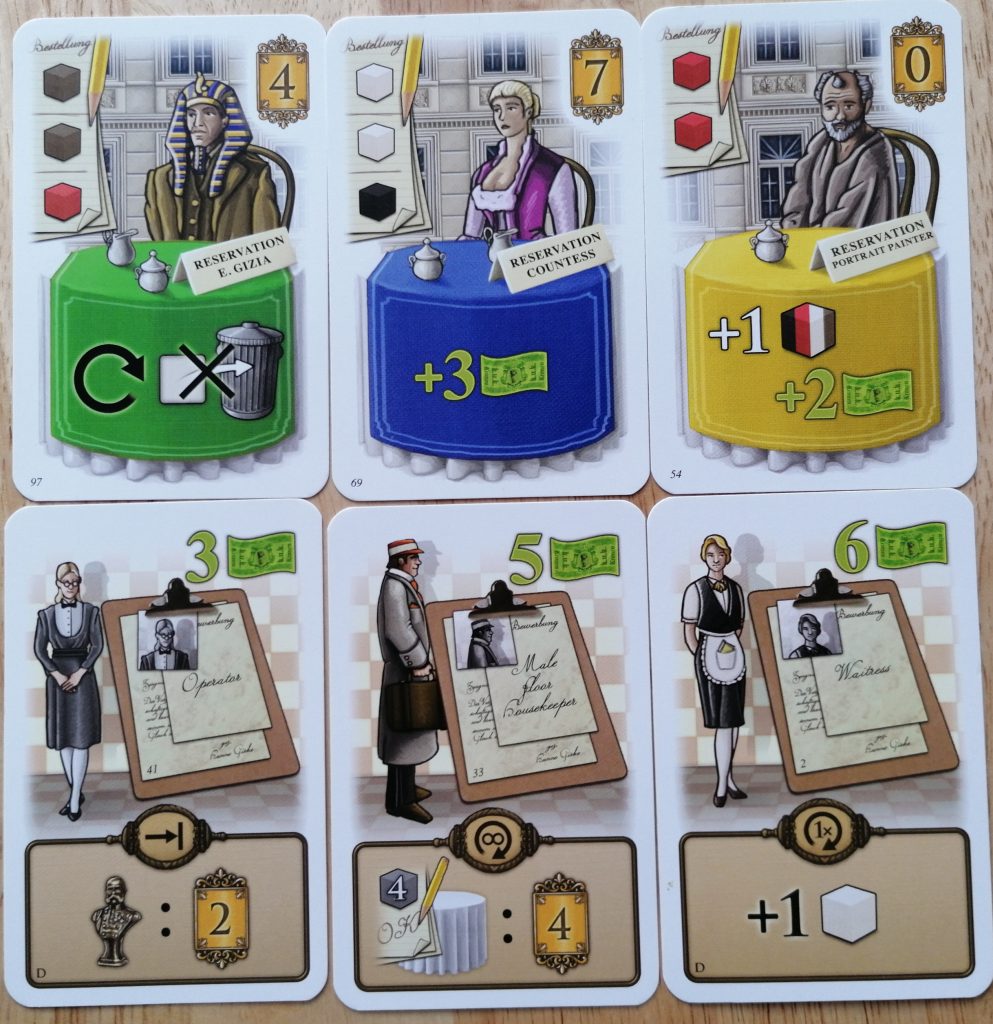
Each guest card is made up of a few different elements. In the top right will be the points you gain once you have been able to put them into a room. The different coloured cubes in the top left indicate what they need from the restaurant before you can put them in a room. Then there is the table, which indicates what coloured room you can put them in, and also what bonus you gain once they are completed. Most of the time these will be simple, but they are important to keep in mind when taking a guest into your restaurant. You are also limited to three in your restaurant at once, so it’s important to try to move them to rooms as quickly as you can.
The other type of cards pictured are staff cards. At the beginning of the game, each player will be dealt six of these, and will keep them hidden until they choose to play them. Every card is unique, and all are powerful in their own way. I find that the costs associated to the abilities are quite evenly balanced, as each card can have a one-time, once per round, permanent or end of game effect. A minor issue I have with these is that there are very few ways to draw more. Obviously, you get six to begin with, so this may be plenty for some players, and in a way it is for me as well, but I may get six cards that don’t necessarily work for me, and I can’t do much to gain any new ones.
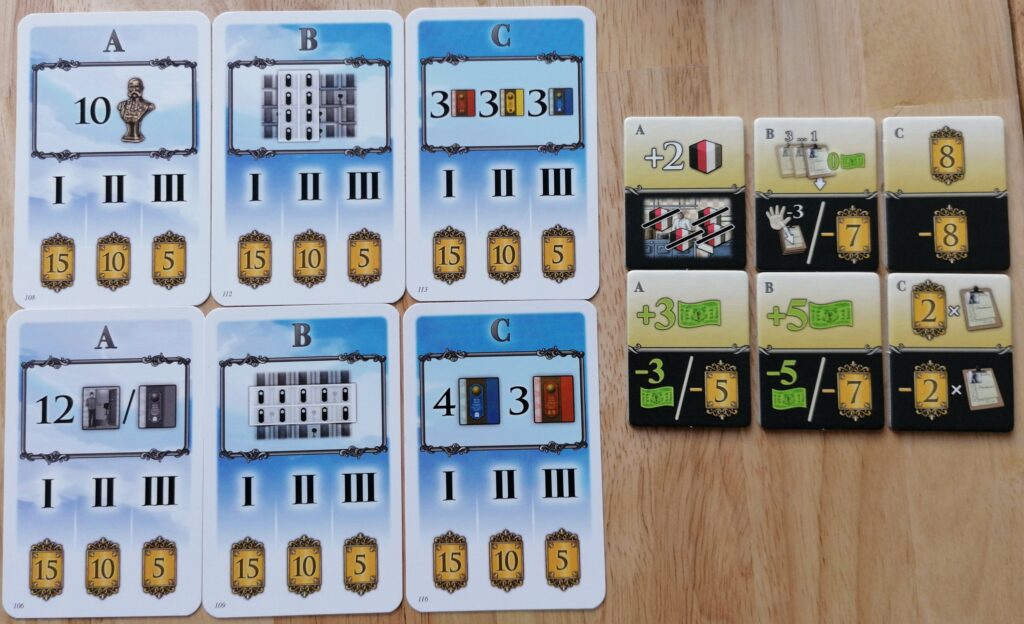
There are two other important parts of the main board which you will have to keep an eye on. As part of setup, you will place out three objective cards and three objective tiles. These are for all players, but they work in different ways. The cards award players points based on who completed the objective first, second and third, and they will mainly relate to what’s on your own player board. Some of them, however, will relate to the emperor’s track, and this is where the tiles come into play.
At the end of rounds three, five and seven, each player will check on where their disc is on this track, and gain the amount of points shown beneath the track related to their position. After this, they will move their disc back on the track three, five or seven spaces (equivalent to the round number). If your disc now occupies space one or two (where the background is white), nothing happens. If your disc is in position three or above (gold), then you gain a reward, and if it is on zero (black), something negative happens, which are shown on the equivalent colours on the tile. Based on which round you’re in, the benefits/negatives will get better/worse. I enjoy how the emperor’s track works, keeping you alert and giving you something other than just the guests to concentrate on, but it is also a very punishing part of the game, and sometimes it can come down to a bit of bad luck if you’re not able to move up the track. Aside from the dice drafting action to move up, your only other hopes are if a guest card’s bonus lets you move up, or if you have a staff card which lets you move up. Other players will also be gunning for the guests which let you do this, and it’s possible that none of your staff will help you. This, teamed with the fact that you only get, at most, six actions before the next time it is evaluated, you might find it difficult to pull off.
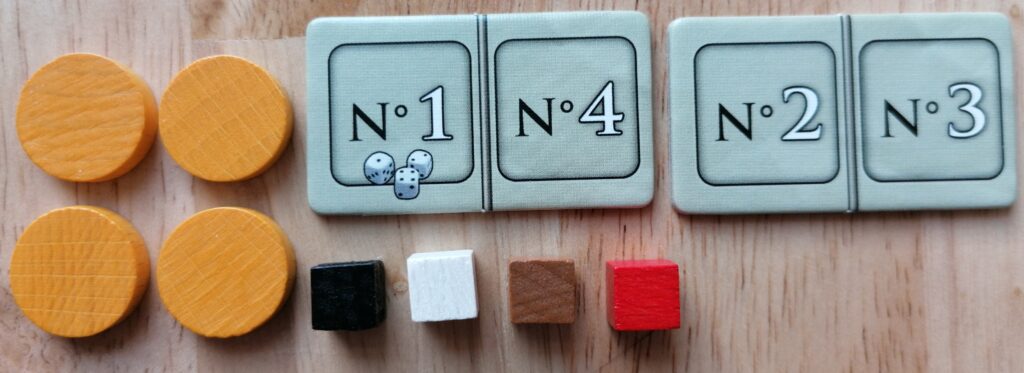
The production in Grand Austria Hotel is a bit of a mixed bag in my opinion. I like the art throughout the game, and the addition of easter eggs in the form of the green guests (usually hinting towards other games or real-world figures) is a fun little extra. Though there is a lot of symbology in the game, the rulebook explains what every single one means, even including a couple of pages where it goes through every staff card individually. I like how the room tiles are double-sided, with one side showing an open door, and one side showing a ‘please do not disturb’ sign. The tiles each player receives for the dice they take, though not really necessary, clearly tell you in what order you take each die based on the snake draft. On the other hand, the dice, while functional, are basic white dice. The discs you get to mark various tracks are underwhelming. Rather than getting coins or tokens to indicate your money, you just have a track on your board, and where it probably cuts down on cost and more pieces in the game, it is nice to have coins or tokens. My main issue though lies with the resource cubes, which are very small, but also, as I’m a little colour-blind, it’s sometimes a little difficult to distinguish the red and brown cubes.
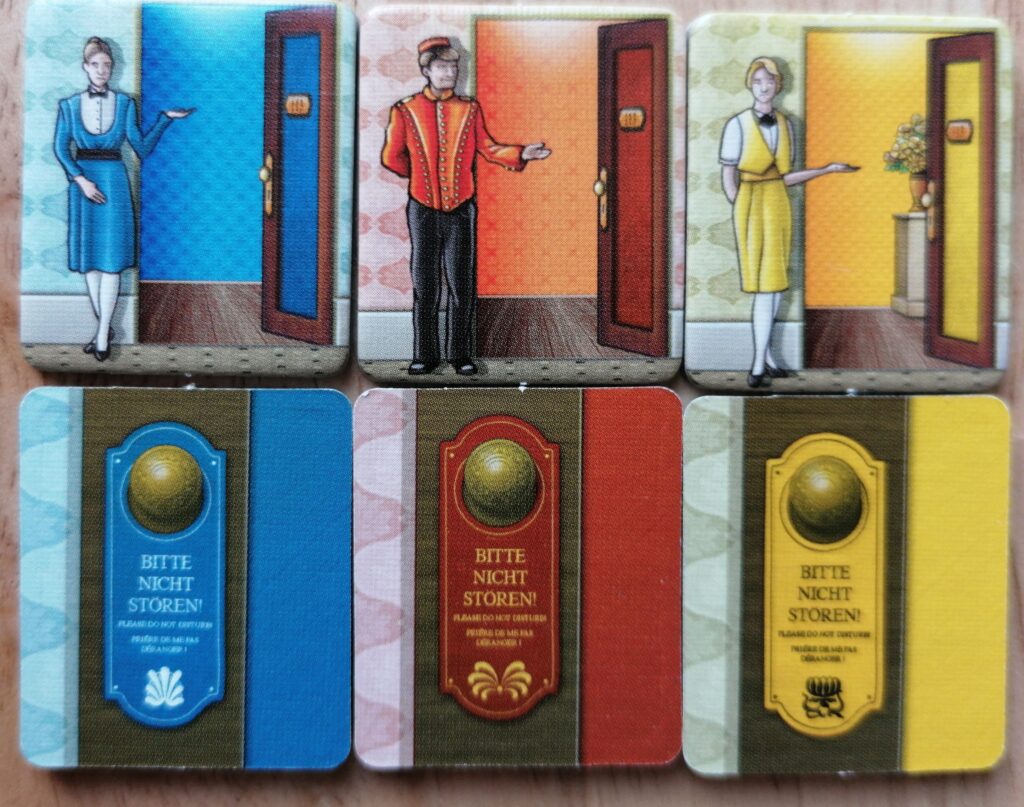
Grand Austria Hotel is a game that could mislead people. The theme is an attractive one, and the mechanisms used in the game are, in my opinion, very well done, but it can punish you, very quickly and brutally, and if you’re not ready it could ruin your game. It’s a game that I didn’t instantly take to, as I found it difficult to adjust for this, but once I had a few plays under my belt, I started to really enjoy it.

